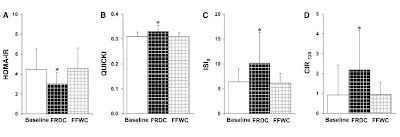Dark Chocolate Reduces Blood Pressure and Improves Insulin Sensitivity in Just Two Weeks
Everyone knows that dark chocolate is healthy, but how many of us really know why exactly it's healthy? It's the same as with red wine: it's common knowledge that it's healthy – it contains those magical polyphenols, after all – but the actual effects are mentioned less frequently.
Most things that are labeled healthy by mainstream media are things that reduce the risk of cardiovascular disease. The same is true of red wine and dark chocolate, although I'm sure there's more to them than just heart health. Resveratrol, found in red wine, for example has a multitude of effects. What I found interesting, however, is how quickly dark chocolate can have a beneficial effect on two common health problems: blood pressure and glucose intolerance (link).
Study design
To study how dark chocolate affects glucose tolerance, insulin sensitivity and blood pressure, 19 subjects with hypertension and impaired glucose tolerance were chosen for the experiment. Smokers and those with significant overweight (BMI > 30) or diabetes were excluded.
The subjects were then randomized and given either 100 grams of flavonol-rich dark chocolate or flavonol-free white chocolate for 15 days. They were told to eat the chocolate in two 50 gram doses, one for breakfast and one for lunch. After a washout period of one week the two treatments were switched, so that those who had been eating dark chocolate got white chocolate instead and vice versa.
Results
Two weeks of dark chocolate consumption decreased insulin resistance significantly compared to baseline and white chocolate. The graphs below show the results from various measurements.
The graph on the left show the results from the homeostasis model asssessment of insulin resistance (HOMA-IR) for baseline, flavonoid-rich dark chocolate (FRDC) and flavonoid-free white chocolate (FFWC). The three other graphs show the differences in insulin sensitivity. White chocolate had no effect on any of the tests, while dark chocolate improved glucose and insulin responses to the oral glucose tolerance test.
Compared to baseline, blood pressure decreased after dark chocolate consumption. White chocolate had no effect on 24-h, daytime or nighttime blood pressure. The graphs below show the changes in systolic and diastolic blood pressure.
Dark chocolate also increased flow-mediated dilation, which measures endothelial function. Again, white chocolate had no effect compared to baseline. Interestingly, dark chocolate also reduced LDL cholesterol compared to baseline and white chocolate but had no effect on triglycerides and HDL.
Conclusion
In people with hypertension and impaired insulin sensitivity, dark chocolate (but not white chocolate) reduced blood pressure and improved glucose tolerance and insulin sensitivity. Endothelial function was also improved.
What's interesting about this study is that the duration was so short: the participants saw improvements in just two weeks. And, unlike in many studies, they weren't given cocoa powder or a small dose of dark chocolate, but an entire 100 gram chocolate bar for each day. Also, the subjects were not diabetic, and they only had stage 1 hypertension (systolic 140-159 mmHg, diastolic 90-99 mmHg), which suggests that dark chocolate is helpful even before things get really bad.
I try to keep my intake at around 50 grams per day on average, but at least this study shows that higher amounts are not bad for cholesterol, blood pressure or insulin sensitivity. The reasons I try to stay below 100 grams are the high iron and copper contents and possible lead contamination in cocoa powder.
Still, if you're eating milk chocolate with a low cocoa content (typically around 30%), consider upping the ante and slowly progressing towards darker chocolates. It's the better choice in at least five different ways.
For more information on blood pressure, insulin and cholesterol, see these posts:
Hibiscus Tea Increases HDL, Lowers LDL and Triglycerides
The Many Health Benefits of Rooibos Tea
Intermittent Fasting Improves Insulin Sensitivity Even without Weight Loss
Intermittent Fasting with a Condensed Eating Window – Part III: Fasting Blood Glucose, Cortisol & Conclusion








